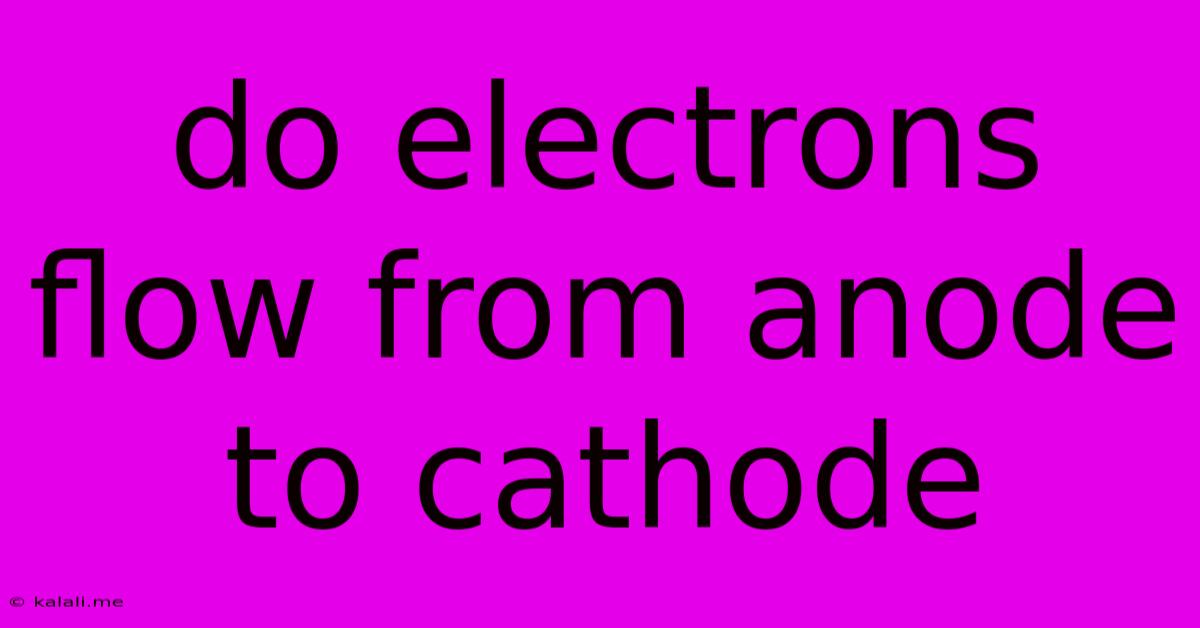Do Electrons Flow From Anode To Cathode
Kalali
Jun 04, 2025 · 3 min read

Table of Contents
Do Electrons Flow from Anode to Cathode? Understanding Electron Flow in Circuits
Meta Description: This article clarifies the direction of electron flow in electrical circuits, explaining the roles of the anode and cathode, and debunking common misconceptions about current flow. Learn the difference between electron flow and conventional current.
The question of whether electrons flow from anode to cathode is a fundamental concept in understanding electricity, yet it's often a source of confusion. The simple answer is yes, electrons flow from the cathode to the anode. However, understanding this requires clarifying some crucial terminology and historical context.
Understanding Anode and Cathode
The terms "anode" and "cathode" describe the electrodes in an electrochemical cell (like a battery) or a vacuum tube. Their definitions are based on the direction of electron flow, not the type of charge.
-
Cathode: The electrode where electrons enter a device or circuit. In other words, it's the point of reduction (gaining electrons). Think of it as the "electron source".
-
Anode: The electrode where electrons leave a device or circuit. This is where oxidation occurs (losing electrons). It's the "electron sink".
The Confusion: Electron Flow vs. Conventional Current
The confusion arises from the historical development of electrical theory. Before the discovery of the electron, scientists established the convention of current flow as the movement of positive charge from positive to negative. This is known as conventional current. It's important to understand that conventional current flows from anode to cathode, the opposite direction of actual electron flow.
While conventional current is still widely used in circuit diagrams and calculations, it's essential to remember that it represents a historical convention, not the actual movement of charge carriers. In reality, electrons, which carry a negative charge, are the primary charge carriers in most electrical circuits.
Electron Flow in Different Contexts
The direction of electron flow isn't always straightforward and depends on the context:
-
Batteries: In a battery, electrons flow out of the negative terminal (cathode) through the external circuit and into the positive terminal (anode). Chemical reactions within the battery maintain this electron flow.
-
Electrolysis: During electrolysis, an external power source forces electrons to flow into the cathode, causing reduction. Electrons flow out of the anode, causing oxidation.
-
Semiconductors: In semiconductors, the movement of both electrons and "holes" (the absence of electrons) contributes to current flow, adding another layer of complexity.
Why the Confusion Matters
Understanding the difference between electron flow and conventional current is crucial for several reasons:
-
Accurate circuit analysis: While conventional current simplifies calculations in many cases, a complete understanding of electron flow is needed for advanced analysis, especially in semiconductor devices.
-
Avoiding misconceptions: Confusing the two can lead to incorrect interpretations of how electronic devices function.
-
Clear communication: Using the correct terminology ensures clear and unambiguous communication within the field of electronics and electrical engineering.
In summary, while conventional current flows from anode to cathode, it's vital to remember that electrons actually flow from cathode to anode. Understanding this distinction provides a more accurate and comprehensive understanding of electricity and circuit behavior. The ongoing use of conventional current highlights the importance of context and historical perspective in science.
Latest Posts
Latest Posts
-
How Do You Change Recessed Light Bulbs
Jun 05, 2025
-
Wiring Diagram For Four Way Switch
Jun 05, 2025
-
Access Custom Meta Data Object In Profile
Jun 05, 2025
-
Please Feel Free To Add Attendees
Jun 05, 2025
-
Why Do Bus Drivers Open The Door At Railroads
Jun 05, 2025
Related Post
Thank you for visiting our website which covers about Do Electrons Flow From Anode To Cathode . We hope the information provided has been useful to you. Feel free to contact us if you have any questions or need further assistance. See you next time and don't miss to bookmark.